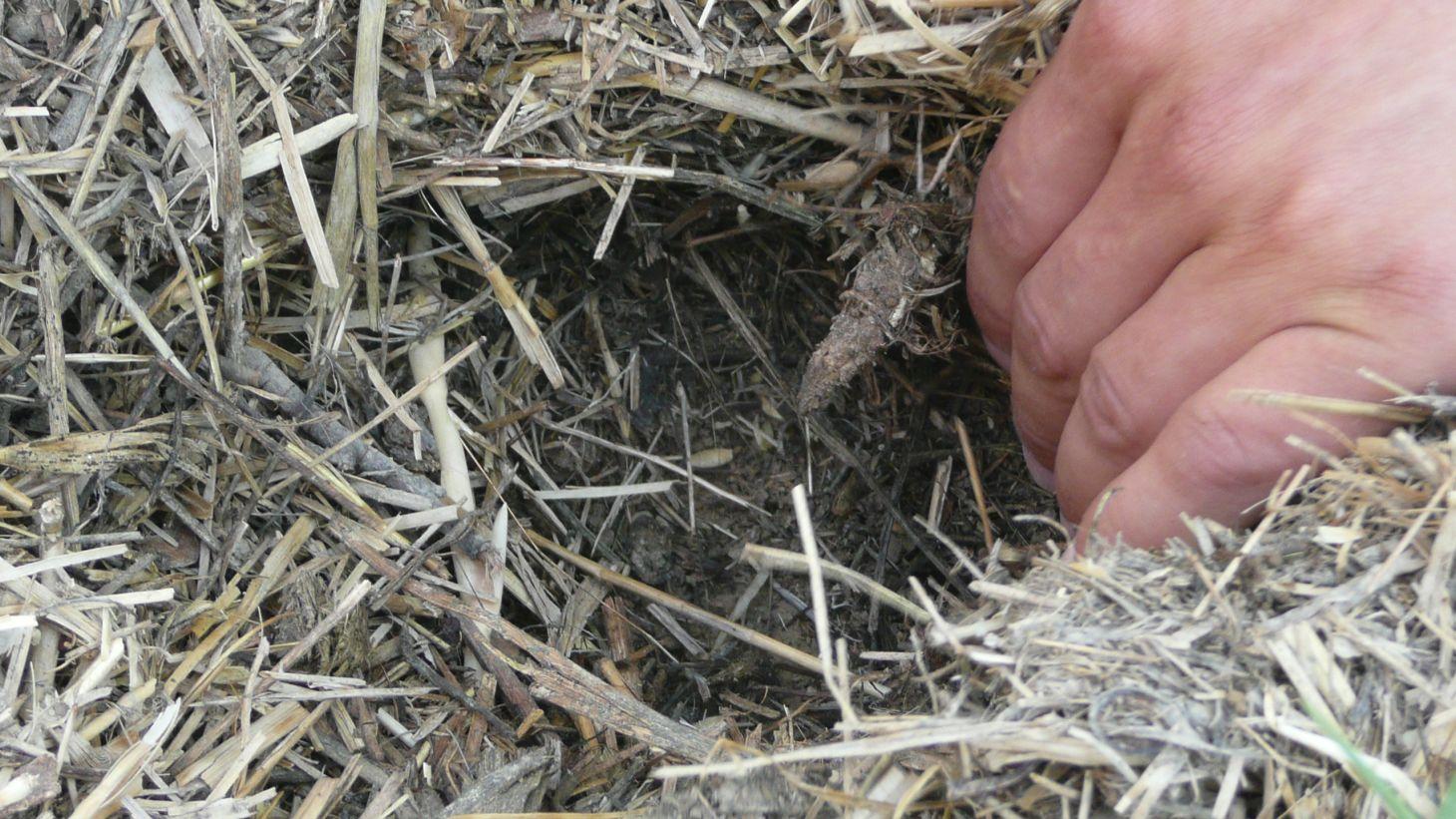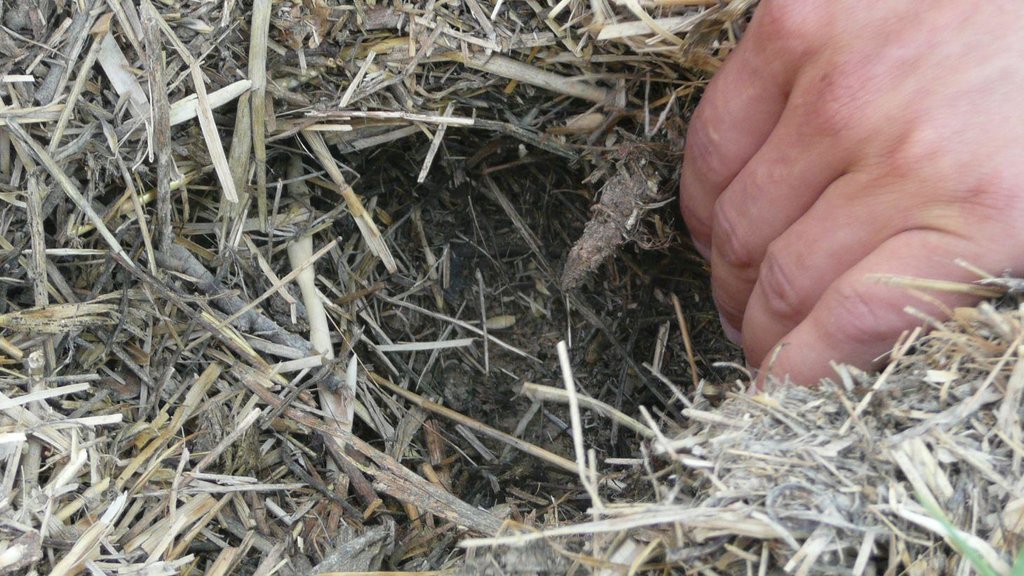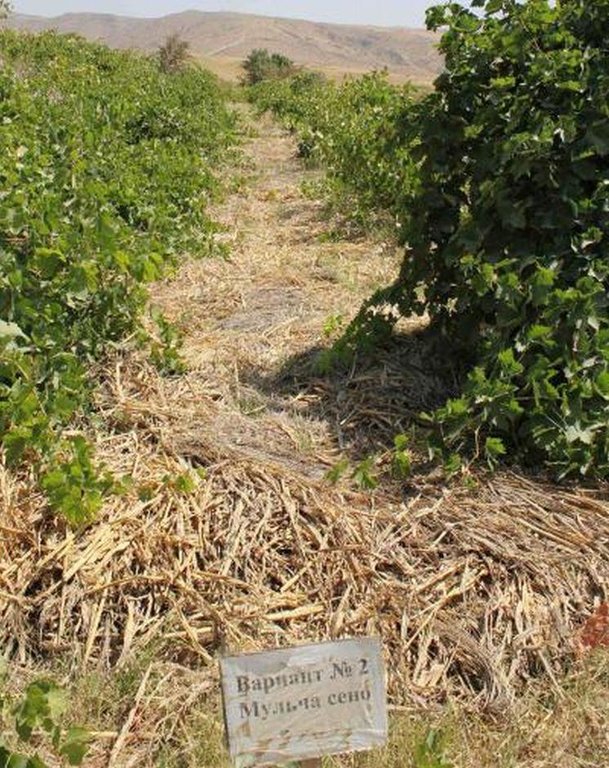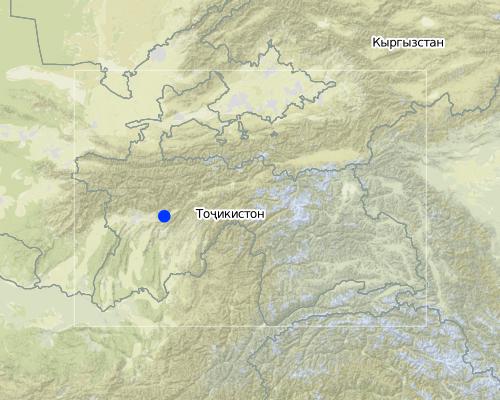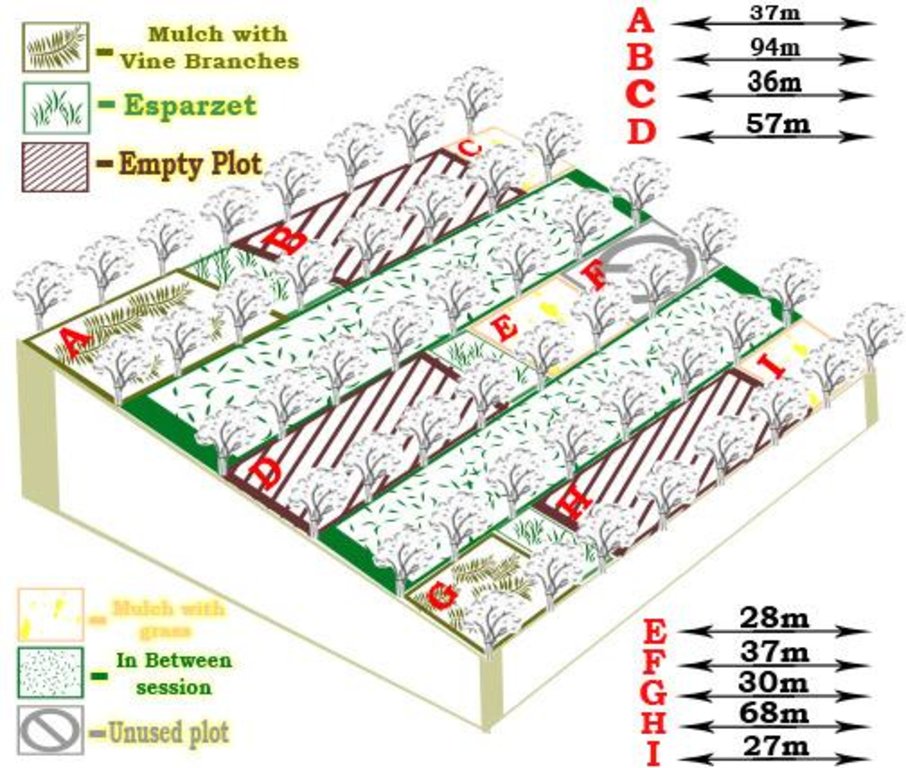Mulching in rainfed vineyards on terraces in the loess hill zone [طاجيكستان]
- تاريخ الإنشاء:
- تحديث:
- جامع المعلومات: Qobiljon Shokirov
- المحرر: –
- المُراجع: David Streiff
Mulcha Sino
technologies_1111 - طاجيكستان
عرض الأقسام
توسيع الكل طي الكل1. معلومات عامة
1.2 تفاصيل الاتصال بالأشخاص الرئيسيين لمصدر المعلومات والمؤسسات المشاركة في تقييم وتوثيق التقنية
متخصص في الإدارة المستدامة للأراضي:
Boev Jahonbek
jahonbek.boev@mail.ru
Tajik Soil Institute
طاجيكستان
اسم المؤسسة (المؤسسات) التي سهلت توثيق/تقييم التقنية (إذا كان ذلك على صلة)
Tajik Soil Insitute (Tajik Soil Institute) - طاجيكستاناسم المؤسسة (المؤسسات) التي سهلت توثيق/تقييم التقنية (إذا كان ذلك على صلة)
NCCR North-South (NCCR North-South) - قرغيزستان1.3 الشروط المتعلقة باستخدام البيانات الموثقة من خلال WOCAT
متى تم تجميع البيانات (ميدانيا)؟:
22/08/2011
يوافق جامع المعلومات والشخص (لاشخاص) الرئيسي لمصدر المعلومات على الشروط المتعلقة باستخدام البيانات الموثقة من خلال WOCAT:
نعم
2. وصف تقنيةالإدارة المستدامي للأراضي
2.1 وصف مختصر للتقنية
تعريف التقنية:
This technology consists of vineyards plots that are mulched with grass and established on terraced land in the loess hills of Tajikistan.
2.2 وصف تفصيلي للتقنية
الوصف:
On the terrain of the Tajik Soil Institut's research station in Karsang, Faizabad District, Tajikistan, a vineyard was established on forward sloping terraces with about 12° inclination on land formerly used as extensive pastures. This technology dates back to the times of the Soviet Union in 1968. Bulldozers were used to establish the terraces.
Before the planting of vines the soil was ploughed. Local vine sorts were used for the plantation and intercropping is done with wheat and fodder crops. About 1300 vine seedlings were planted per hectare.
Purpose of the Technology: Mulching treatment with grass was initiated to increase soil moisture in the soil, improve soil quality such as soil organic matter and other elements and protect soil from erosion by water and wind.
Establishment / maintenance activities and inputs: Mulching with grass was set up by the Tajik Soil Institute and but has been maintained by the farmers who lease the land. Mulching with grass is relatively easy but can be very challenging; depending on the availability of resources. First, plots between the vineyard rows were ploughed by using animal power, in most cases horses. Natural grasses were cut from the property of the research station and applied as a mulch in between plots within the designated vineyard plots. Since then the experiment has been maintained by the farmers and over the last ten years layer of mulch with grass has been growing and building up the top soil layer. This layer of mulch prevents rainwater from eroding the top soil, improves soil organic carbon, provides shade to plant roots, and most importantly keeps soil moisture moderately in hot summer months, which is very essential in these rainfed areas.
Natural / human environment: The terraces have greatly helped to reduced soil erosion and the vines supported this effect in further stabilising the soil. Soil humidity has improved through increased soil moisture and reduced evaporation due to mulching throughout the year. As the vineyard was established on pasture land, a disadvantage is the reduced grazing land area. The disadvantage of mulching is that no inter cropping between the vines can take place for several years.
In summer of 2011, WOCAT questionnary was used to analyze and evaluate current conditions of the vineyard mulching treatment. At the same time proper soil samples were taken from the plots with mulch and control plots in 0-15 and 15-30cm for further comparison for soil organic carbon (SOC). All together 240 soil samples were taken from eight different plots and each have been analyzed for soil SOC content.
From this study it was revealed that plots with mulch has significantly higher SOC content than control plots. In average, plots with mulch consisted of 1.3% SOC and control plots in average contained 0.4% SOC within the 0-15cm depths. Average SOC content for plots with mulch and control plots were observed but there were no significant difference in 30cm depth, both contained 0.4-0.5% of SOC.
2.3 صور التقنية
2.5 البلد/المنطقة/المواقع التي تم تنفيذ التقنية فيها والتي يغطيها هذا التقييم
البلد:
طاجيكستان
المنطقة/الولاية/المحافظة:
RRS
مزيد من التفاصيل حول الموقع:
Faizabad, Javonon, Karsang
Map
×2.6 تاريخ التنفيذ
في حالة عدم معرفة السنة بالتحديد، يرجى الإشارة إلى التاريخ التقريبي:
- منذ أقل من 10 سنوات (مؤخرًا)
2.7 إدخال التقنية
حدد كيف تم إدخال التقنية:
- أثناء التجارب/الأبحاث
التعليقات (نوع المشروع، الخ):
The vineyard was originally set up 60 years ago but the mulching experiment within the vineyard was introduced around 2000-2003.
3. تصنيف تقنية الإدارة المستدامي للأراضي
3.1 الغرض الرئيسي ( الأغراض الرئيسية) للتقنية
- الحد من تدهور الأراضي ومنعه وعكسه
3.2 نوع (أنواع) استخدام الأراضي الحالية حيث يتم تطبيق التقنية

الأراضي الزراعية
- زراعة معمرة (غير خشبية)

مختلطة (محاصيل/ رعي/ أشجار)، بما في ذلك الحراجة الزراعية
- الحراجة الزراعية
التعليقات:
Major land use problems (compiler’s opinion): soil erosion through wind and water, soil moisture loss, soil nutrient mining
Major land use problems (land users’ perception): soil fertility and humidity decline, lack of technical equipment, low productivity of non-irrigated land on slopes when used in a conventional way as cropland of extensive pasture
Future (final) land use (after implementation of SLM Technology): Mixed: Mf: Agroforestry
إذا تغير استخدام الأراضي بسبب التقنية، قم بالإشارة إلى استخدام الأرض قبل تنفيذ التقنية:
Grazing land: Ge: Extensive grazing land
3.3 مزيد من المعلومات حول استخدام الأراضي
إمدادات المياه للأرض التي يتم تنفيذ التقنية عليها:
- بعلية
عدد مواسم الزراعة في السنة:
- 1
حدد:
Longest growing period from month to month: April to November
3.4 مجموعةالإدارة المستدامة للأراضي التي تنتمي إليها هذه التقنية
- الحراجة الزراعية
- تحسين الغطاء الأرضي/النباتي
- التدابير المتقاطعة للمنحدرات
3.5 انتشار التقنية
حدد انتشار التقنية:
- منتشرة بالتساوي على مساحة
إذا كانت التقنية منتشرة بالتساوي على منطقة ما، فحدد المنطقة التقريبية المغطاة:
- < 0.1 كم2 (10 هكتار)
التعليقات:
Total area covered by the SLM Technology is 0.07 m2.
3.6 التدابير التقنية في مجال إلادارة المستدامة للأراضي

التدابير الزراعية
- A1: الغطاء النباتي/التربة

التدابير النباتية
- V1: غطاء من الأشجار والشجيرات

التدابير البنيوية
- S1: المصاطب المتدرجة

التدابير الإدارية
- M1: التغيير في نوع استخدام الأراضي
التعليقات:
Main measures: agronomic measures, vegetative measures
Secondary measures: structural measures, management measures
Type of agronomic measures: mulching, breaking compacted topsoil, zero tillage / no-till
Type of vegetative measures: aligned: -contour
3.7 الأنواع الرئيسية من تدهور الأراضي التي تناولتها التقنية

تآكل التربة بالمياه
- الوزن(Wt): فقدان التربة السطحية/تآكل السطح
- (Wg):الانجراف الخلجاني/ الخلجان
التعليقات:
Main type of degradation addressed: Wt: loss of topsoil / surface erosion
Secondary types of degradation addressed: Wg: gully erosion / gullying
Main causes of degradation: soil management (Plowing), overgrazing, Heavy / extreme rainfall (intensity/amounts)
Secondary causes of degradation: wind storms / dust storms, droughts, governance / institutional (common grazing land in the vicinity of the village regulated management)
3.8 منع أو حد أو عكس تدهور الأراضي
تحديد هدف التقنية فيما يتعلق بتدهور الأراضي:
- منع تدهور الأراضي
- الحد من تدهور الأراضي
التعليقات:
Main goals: prevention of land degradation
Secondary goals: mitigation / reduction of land degradation, rehabilitation / reclamation of denuded land
4. المواصفات الفنية، وأنشطة التنفيذ، والمدخلات، والتكاليف
4.1 الرسم الفني للتقنية
4.2 المواصفات الفنية/شروحات الرسم الفني
Location: Faizabad, Tajikistan. RRS
Date: September, 2011
Technical knowledge required for field staff / advisors: moderate
Technical knowledge required for land users: moderate
Main technical functions: control of raindrop splash, control of dispersed runoff: impede / retard, improvement of ground cover, increase in organic matter, increase in nutrient availability (supply, recycling,…), increase / maintain water stored in soil
Secondary technical functions: control of dispersed runoff: retain / trap, improvement of surface structure (crusting, sealing), stabilisation of soil (eg by tree roots against land slides), increase of infiltration, water harvesting / increase water supply, increase of biomass (quantity)
Diversion ditch/ drainage
Material: earth
Mulching
Material/ species: grass
Quantity/ density: 15-20cm
Remarks: mulch layer thickness (15-20cm)
Breaking compacted topsoil
Material/ species: loosing of soil around vines, yearly
Zero tillage / no-till
Material/ species: zero tillage between the vines on the terraces
Aligned: -contour
Vegetative material: F : fruit trees / shrubs
Number of plants per (ha): 1300
Spacing between rows / strips / blocks (m): 3
Vertical interval within rows / strips / blocks (m): 2
Fruit trees / shrubs species: vineyards "rosevitaiti", improved local sorts
Terrace: bench level
Width of bunds/banks/others (m): 3
Vegetation is used for stabilisation of structures.
4.3 معلومات عامة بخصوص حساب المدخلات والتكاليف
حدد العملة المستخدمة لحساب التكاليف:
- دولار أمريكي
أشر إلى سعر الصرف من الدولار الأمريكي إلى العملة المحلية (إذا كان ذا صلة): 1 دولار أمريكي =:
-2,13
اذكر متوسط تكلفة أجر العمالة المستأجرة في اليوم الواحد:
6.5
4.4 أنشطة التأسيس
| النشاط | نوع التدبير | التوقيت | |
|---|---|---|---|
| 1. | Planting | نباتية | |
| 2. | Terracing by bulldozer | بنيوية أو هيكلية | late autumn / early spring |
4.5 التكاليف والمدخلات اللازمة للتأسيس
| تحديد المدخلات | الوحدة | الكمية | التكاليف لكل وحدة | إجمالي التكاليف لكل مدخل | % من التكاليف التي يتحملها مستخدمو الأراضي | |
|---|---|---|---|---|---|---|
| العمالة | Planting | Persons/day | 13,0 | 6,5 | 84,5 | |
| العمالة | Terracing by bulldozer | hours | 16,0 | 2,81222 | 45,0 | |
| معدات | Bulldozer rent | hours | 16,0 | 0,8125 | 13,0 | |
| المواد النباتية | Seedlings | Seeds/ha | 1300,0 | 0,5 | 650,0 | |
| الأسمدة والمبيدات الحيوية | Fertilizer | kg | 5,0 | 1,0 | 5,0 | |
| مواد البناء | Grass | tons | 1,0 | 165,0 | 165,0 | |
| إجمالي تكاليف إنشاء التقنية | 962,5 | |||||
4.6 الصيانة/الأنشطة المتكررة
| النشاط | نوع التدبير | التوقيت/الوتيرة | |
|---|---|---|---|
| 1. | cutting of grass | زراعية | spring/once a year |
| 2. | soil loosening around the trees | زراعية | |
| 3. | Mulching | زراعية | spring (end of April/beginning of May) |
| 4. | Cutting the grass | نباتية | 1 |
| 5. | Protecting the vineyard from animals | نباتية | autumn to spring |
4.7 التكاليف والمدخلات اللازمة للصيانة/للأنشطة المتكررة (سنويًا)
| تحديد المدخلات | الوحدة | الكمية | التكاليف لكل وحدة | إجمالي التكاليف لكل مدخل | % من التكاليف التي يتحملها مستخدمو الأراضي | |
|---|---|---|---|---|---|---|
| العمالة | Cutting of grass | Persons/day | 5,0 | 6,5 | 32,5 | |
| العمالة | Soil loosening | Persons/day | 2,0 | 6,5 | 13,0 | |
| العمالة | Cutting the grass 2nd time | Persons/day | 4,0 | 6,5 | 26,0 | |
| معدات | Mulching | tons | 1,0 | 86,0 | 86,0 | |
| معدات | Scissors | ha | 1,0 | 60,0 | 60,0 | |
| إجمالي تكاليف صيانة التقنية | 217,5 | |||||
التعليقات:
Machinery/ tools: scissors, hoes
The establishment of the vineyard took place in Soviet times and costs were born by the Soil Institute, which is a state institution. However, costs were calculated based on current costs (2011).
5. البيئة الطبيعية والبشرية
5.1 المناخ
هطول الأمطار السنوي
- < 250 مم
- 251- 500 ملم
- 501 - 750ملم
- 1,000-751 ملم
- 1,500-1,100 ملم
- 2,000-1,500 ملم
- 3,000-2,001 ملم
- 4,000-3,100 ملم
- > 4000 ملم
المنطقة المناخية الزراعية
- شبه قاحلة
Thermal climate class: temperate
5.2 طوبوغرافيا
متوسط الانحدارات:
- مسطح (0-2%)
- بسيط (3-5%)
- معتدل (6-10%)
- متدحرج (11-15%)
- تلال (16-30%)
- شديدة الانحدار(31-60%)
- فائقة الانحدار (>60%)
التضاريس:
- هضاب/سهول
- أثلام مرتفعة
- المنحدرات الجبلية
- منحدرات التلال
- منحدرات في السفوح
- قاع الوادي
المنطقة الارتفاعية:
- 100-0 متر فوق سطح البحر
- 500-101 متر فوق سطح البحر
- 1,000-501 متر فوق سطح البحر
- 1,500-1,001 متر فوق سطح البحر
- 2,000-1,501 متر فوق سطح البحر
- 2,500-2,100 متر فوق سطح البحر
- 3,000-2,501 متر فوق سطح البحر
- 4,000-3,001 متر فوق سطح البحر
- > 4000 متر فوق سطح البحر
5.3 التربة
متوسط عمق التربة:
- ضحل جدًا (0-20 سم)
- ضحلة (21-50 سم)
- متوسطة العمق (51-80 سم)
- عميقة (81-120 سم)
- عميقة جدًا (> 120 سم)
قوام التربة (التربة السطحية):
- متوسط ( طميي، سلتي)
المواد العضوية في التربة السطحية:
- متوسطة (1-3%)
إذا كان متاحًا، قم بإرفاق وصف كامل للتربة أو تحديد المعلومات المتوفرة، على سبيل المثال نوع التربة، الرقم الهيدروجيني/ درجة حموضة التربة، قدرة التبادل الكاتيوني، النيتروجين، الملوحة وما إلى ذلك.
Soil fertility is medium
Soil drainage / infiltration is poor
5.4 توافر المياه ونوعيتها
منسوب المياه الجوفية:
50-5 م
توافر المياه السطحية:
متوسط
نوعية المياه (غير المعالجة):
مياه شرب جيدة
5.5 التنوع البيولوجي
تنوع الأنواع:
- منخفض
5.6 خصائص مستخدمي الأراضي الذين يطبقون التقنية
التوجه السوقي لنظام الإنتاج:
- الكفاف (الإمداد الذاتي)
الدخل من خارج المزرعة:
- أقل من % 10من كامل الدخل
أفراداً أو مجموعات:
- موظف (شركة، حكومة)
مستوى المكننة:
- عمل يدوي
- ميكانيكية/ مزودة بمحرك
الجنس:
- رجال
اذكر الخصائص الأخرى ذات الصلة لمستخدمي الأراضي:
Annual population growth: 1% - 2%
Subsistence (self-supply) is supported by the local Institution.
All three levels of mechanization are existing.
5.7 متوسط مساحة الأرض المملوكة أو المستأجرة من قبل مستخدمي الأراضي الذين يطبقون التقنية
- < 0.5 هكتارا
- 0.5 - 1 هكتار
- 1 -2 هكتار
- 2 - 5 هكتار
- 5 - 15 هكتار
- 15 - 50 هكتار
- 50 - 100هكتار
- 500-100 هكتار
- 1,000-500 هكتار
- 10,000-1,000 هكتار
- > 10,000 هكتار
هل يعتبر هذا نطاقًا صغيرًا أو متوسطًا أو واسعا (في إشارة إلى السياق المحلي)؟:
- على نطاق متوسط
5.8 ملكية الأراضي، وحقوق استخدام الأراضي، وحقوق استخدام المياه
ملكية الارض:
- دولة
حقوق استخدام الأراضي:
- مؤجر
- research
- research
التعليقات:
harvest: 50% to state / 50% to land user
5.9 الوصول إلى الخدمات والبنية التحتية
الصحة:
- ضعيف
- معتدل
- جيد
التعليم:
- ضعيف
- معتدل
- جيد
المساعدة التقنية:
- ضعيف
- معتدل
- جيد
العمل (على سبيل المثال خارج المزرعة):
- ضعيف
- معتدل
- جيد
الأسواق:
- ضعيف
- معتدل
- جيد
الطاقة:
- ضعيف
- معتدل
- جيد
الطرق والنقل:
- ضعيف
- معتدل
- جيد
مياه الشرب وخدمات الصرف الصحي:
- ضعيف
- معتدل
- جيد
الخدمات المالية:
- ضعيف
- معتدل
- جيد
6. الآثار والتصريحات الختامية
6.1 الآثار التي أظهرتها التقنية في الموقع
الآثار الاجتماعية والاقتصادية
الإنتاج
إنتاج المحاصيل
إنتاج الأعلاف
الآثار الايكولوجية
دورة المياه / الجريان السطحي
الجريان السطحي
تصريف المياه الزائدة
التبخر
التربة
رطوبة التربة
غطاء التربة
فقدان التربة
تكون قشرة التربة السطحية/انسداد مسام التربة
تراص التربة
المادة العضوية في التربة/تحت الطبقة c
التنوع البيولوجي: الغطاء النباتي، الحيوانات
الأنواع المفيدة
التعليقات/ حدد:
earthworms
الآثار الايكولوجية الأخرى
Hazards towards adverse events
التعليقات/ حدد:
drought
6.3 تعرض التقنية وحساسيتها لتغير المناخ التدريجي والظواهر المتطرفة/الكوارث المرتبطة بالمناخ (كما يراها مستخدمو الأراضي)
تغير مناخ تدريجي
تغير مناخ تدريجي
| الموسم | نوع التغير المناخي/ المتطرف | كيف تتعامل التقنية مع ذلك؟ | |
|---|---|---|---|
| درجة الحرارة السنوية | زيادة | جيدا |
الظواهر المتطرفة / الكوارث المرتبطة بالمناخ
الكوارث الجوية
| كيف تتعامل التقنية مع ذلك؟ | |
|---|---|
| عاصفة ممطرة محلية | جيدا |
| عاصفة هوائية محلية | جيدا |
الكوارث المناخية
| كيف تتعامل التقنية مع ذلك؟ | |
|---|---|
| جفاف | ليس جيدا |
الكوارث الهيدرولوجية
| كيف تتعامل التقنية مع ذلك؟ | |
|---|---|
| فيضان عام (نهر) | ليس جيدا |
التعليقات:
Different types of mulching are currently being tested to increase soil moisture storage, to build up soil organic matter and thus infiltration capacity and soil fertility properties.
6.4 تحليل التكلفة والعائد
كيف يمكن مقارنة العوائد نسبة لتكاليف الإنشاء (من وجهة نظر مستخدمي الأراضي)؟
عوائد قصيرة الأجل:
إيجابي قليلا
عوائد طويلة الأجل:
إيجابي
كيف تتم مقارنة العوائدمع كلفة الصيانة/التكاليف المتكررة (من وجهة نظر مستخدمي الأراضي)؟
عوائد قصيرة الأجل:
محايد/متوازن
عوائد طويلة الأجل:
إيجابي
التعليقات:
Farmers have noted that usually change can be seen within few years after the technology has established.
6.5 اعتماد التقنية
- 1-10%
إذا كان متاحًا، قم بتحديد الكمية (عدد الأسر المعيشية و/أو المساحةالمغطاة):
10 households (3 percent of stated area)
من بين جميع الذين تبنوا التقنية، كم عدد الذين فعلوا ذلك بشكل تلقائي، أي دون تلقي أي حوافز مادية/مدفوعات؟:
- 100-90%
التعليقات:
100% of land user families have adopted the Technology without any external material support
10 land user families have adopted the Technology without any external material support
Comments on spontaneous adoption: Overall acreage of the all field are roughly 3 hectares.
There is a little trend towards spontaneous adoption of the Technology
6.7 نقاط القوة / المزايا / الفرص التي توفرها التقنية
| نقاط القوة/ المزايا/ الفرص من وجهة نظر مستخدمي الأراضي |
|---|
| Vineyards are adapted to climate and give consistently good harvest. |
| Between the rows there is an additional harvest thanks to intercropping. |
| نقاط القوة/ المزايا/ الفرص من وجهة نظر جامع المعلومات أو غيره من الاشخاص الرئيسيين لمصدر المعلومات |
|---|
| Efficient soil protection. |
|
Very practical and easily adaptable in villages, where grass is available. How can they be sustained / enhanced? At the same time grass can become deficit in villages, because of high number of livestock. In that cases small scale mulching is recommended with rotation system. |
6.8 نقاط ضعف / مساوىء / مخاطر التقنية وسبل التغلب عليها
| نقاط الضعف/ المساوىء/ المخاطر من وجهة نظر جامع المعلومات أو غيره من الاشخاص الرئيسيين لمصدر المعلومات | كيف يمكن التغلب عليها؟ |
|---|---|
| Technology is very practical but so far it has not been taken seriously by the farmers. | Probably, few educational days for knowledge sharing would be very helpful. |
| Grass might be available for small scale mulching but usually not for a big scale, because everyone in the region has high number of livestock and automatically grass is used as fodder for animals. | Maybe mulching can be applied around the trees and not so much for covering entire plots. |
الروابط والوحدات المواضيعية
توسيع الكل طي الكلالروابط
لا يوجد روابط
الوحدات المواضيعية
لا يوجد وحدات مواضيعية


